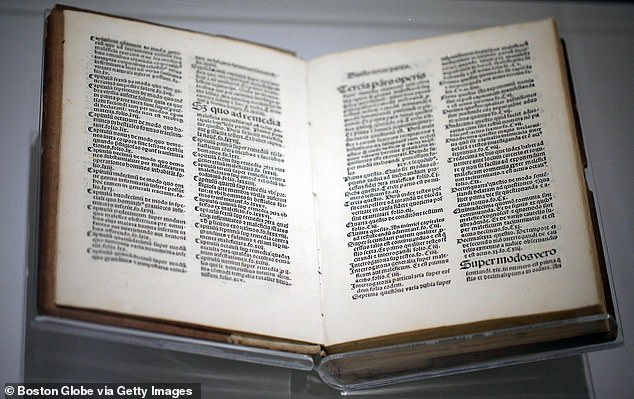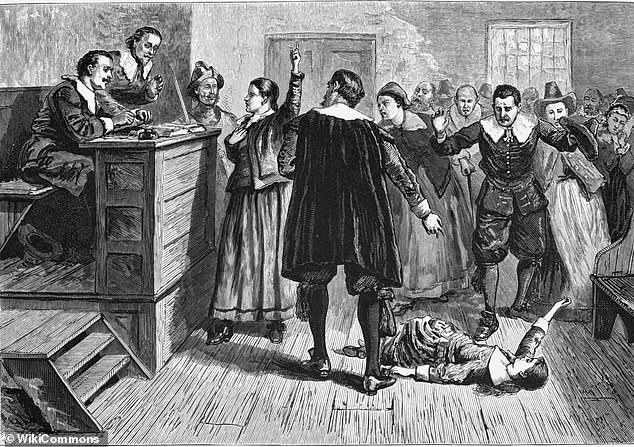Theories about what caused the Salem Witch Trials range from a hallucinogenic mushroom to psychological disorders and economic conditions.
But now, scientists may have settled the debate by identifying the sinister source of the Massachusetts “witch craze” that saw more than 200 people put on trial and 19 executed by hanging 300 years ago.
A new study found that the invention of the printing press in the 15th century, which dramatically increased the spread of information, led to the proliferation of a book containing a detailed explanation of “demonology.”
The widely printed book, Malleus Maleficarum – which translates as the Hammer of Evildoers – described witchcraft as a “conspiratorial activity against pious society” rather than a benign “mischief of village sorceresses, pagans or ignorant peasants”.
This book also served as the first printed guide for witch hunters.
Approximately 36 editions were printed between 1486 and 1669 in Germany, sparking an outbreak of witch hunts across Europe.
While the book never reached the U.S., its teachings traveled with the settlers who settled in Massachusetts.
The Salem Witch Trials were a series of hangings and trials that took place between February 1692 and May 1693 that executed nearly 20 convicted “witches.”
Researchers believe that the message of Malleus Maleficarum spread rapidly through the “diffusion of ideas” or “the adoption of new ideas, which lead social actors to reinterpret the world and thus change their behavior.”
This was made possible by the German inventor Johannes Gutenberg, who created the printing press in 1440.
This momentous invention accelerated the spread of knowledge, discoveries, and literacy around the world, ushering in a new intellectual era.
Malleus Maleficarum, written by the Dominican friar Heinrich Kramer, was first printed in 1486 and quickly became one of the most widely read books on witches and one of the first forms of mass communication.
His message spread first among the literate members of European society and then among the illiterate through conversation.
Eventually, the teachings of the Malleus Maleficarum reached the United States, ushering in a new perception of witchcraft and mobilizing a wave of persecution unlike anything seen before.
Witches were present in folklore long before the Malleus Maleficarum was printed, dating back to the ancient Romans. But this book stoked a new level of fear that ultimately led to tens of thousands of deaths around the world.
“The great innovation of the book was to combine an elaborate theological explanation of witchcraft with practical guidance on the methods of investigation, interrogation and condemnation of witches,” according to the study published in the journal Theory and society.

Malleus Maleficarum, which translates as the Hammer of Evildoers, described witchcraft as a “conspiratorial activity against pious society.”
The researchers mapped the dates and locations of several witch hunts that took place across Central Europe between 1400 and 1679, and compared them to the places where Malleus Maleficarum had been printed and distributed.
They found that “cities closer in time and space to the publication of the Malleus were more likely to initiate witch trials.”
The study suggested that the printing press played a key role in spreading this new perception of witchcraft and thus indirectly fueled the “witch craze” that led to worldwide witch hunts, including trials. of Salem witches.
These infamous trials began when a group of girls from Salem Village, Massachusetts, claimed to be possessed by the devil and accused several local women of witchcraft.
This caused a wave of hysteria to spread throughout colonial Massachusetts, and a special court met in Salem to hold the first trial in 1692.
The first convicted witch, Bridget Bishop, was executed by hanging in June of that year.
In the months after her death, more than 200 people were accused of witchcraft and 19 were executed.
Years later, several of the accusers, most of whom were teenagers, admitted they were lying about the charges. In 1702, the Massachusetts General Court declared the trials illegal and in 1711 overturned the convictions of 22 trial victims.
Today, the Salem Witch Trials are considered one of the most notorious cases of mass hysteria in colonial America.


